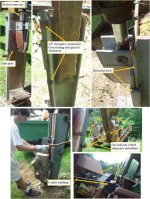F.L. Jennings
Bronze Member
I built this wood splitter attachment for my backhoe last winter and am always trying to make it better, more functional etc. Recently I added the following features that are showing themselves to be very useful.
1. A detachable (just hooks on) wood ramp that is 5 feet long and about 13-14" wide. I made spring loaded anti-rollback bars and placed them along each side. These allow round wood to roll over them then they spring back up and won't let the wood roll back. The ramp will pivot in any direction to suit whatever slope the boom is. The universal joint method even allows the ramp to be used When I use the splitter in a near vertical position. The pivoted foot frame allow the whole thing to be set up level and used as a work platform while splitting wood.
The bucket attachment and linkage pins on the hoe boom were used to mount the assembly.
2. A pair of split wood returns (bringer-backers) that are very loosely connected to the truck assembly (wood pusher). These have proven to be a great labor saver. When wood is split you often want to resplit (sometimes multiple times such as with kindling) and these split wood retractors or "bringer backers" as I jokingly refer to them keep me from having to bend over and pick up all of the split pieces, even though a piece will sometimes fall off.
They are VERY loosely connected (threaded 1/2" studs) to the truck assembly. This loose connection allows them not to be damaged when twisted grain or other unruly wood trys to mess things up.
We started heating with wood again last winter so my tired old bones needed some hydraulic assistance. The whole thing works great and is largely built out of metal I had on hand. The Cylinder rod pin I turned on a 9" lathe andt then welded it to the plate truck assembly. I have split 4 or 5 cords with it so far and can do it right in the woods.
Here are a few drawings of what I have made so far. Mines not all painted yet so these pictures are much more explanatory than a lot of unpainted iron. Some welds are shown unpainted
Thought this might give somebody a few ideas or that you could improve on what I've done. I don't have $50 in the whole thing and it can be removed easily and the bucket re-attached. The tractor is a Kubota L4200 and the backhoe is a 9ft. Bradco. After I get the thing painted up and looking nice I can post pix.


PARTIAL ENLARGED VIEW
1. A detachable (just hooks on) wood ramp that is 5 feet long and about 13-14" wide. I made spring loaded anti-rollback bars and placed them along each side. These allow round wood to roll over them then they spring back up and won't let the wood roll back. The ramp will pivot in any direction to suit whatever slope the boom is. The universal joint method even allows the ramp to be used When I use the splitter in a near vertical position. The pivoted foot frame allow the whole thing to be set up level and used as a work platform while splitting wood.
The bucket attachment and linkage pins on the hoe boom were used to mount the assembly.
2. A pair of split wood returns (bringer-backers) that are very loosely connected to the truck assembly (wood pusher). These have proven to be a great labor saver. When wood is split you often want to resplit (sometimes multiple times such as with kindling) and these split wood retractors or "bringer backers" as I jokingly refer to them keep me from having to bend over and pick up all of the split pieces, even though a piece will sometimes fall off.
They are VERY loosely connected (threaded 1/2" studs) to the truck assembly. This loose connection allows them not to be damaged when twisted grain or other unruly wood trys to mess things up.
We started heating with wood again last winter so my tired old bones needed some hydraulic assistance. The whole thing works great and is largely built out of metal I had on hand. The Cylinder rod pin I turned on a 9" lathe andt then welded it to the plate truck assembly. I have split 4 or 5 cords with it so far and can do it right in the woods.
Here are a few drawings of what I have made so far. Mines not all painted yet so these pictures are much more explanatory than a lot of unpainted iron. Some welds are shown unpainted
Thought this might give somebody a few ideas or that you could improve on what I've done. I don't have $50 in the whole thing and it can be removed easily and the bucket re-attached. The tractor is a Kubota L4200 and the backhoe is a 9ft. Bradco. After I get the thing painted up and looking nice I can post pix.


PARTIAL ENLARGED VIEW







